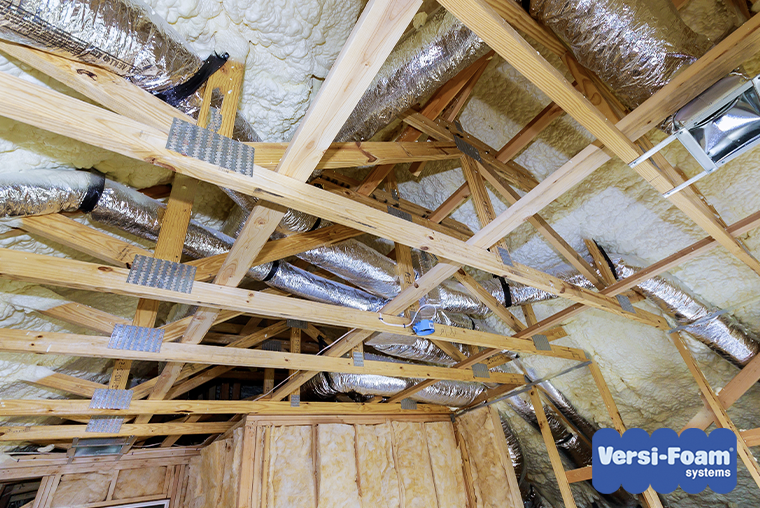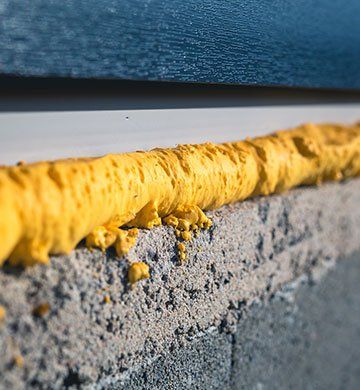Frequently Asked Questions Concerning Spray Foam Installation and Usage
Frequently Asked Questions Concerning Spray Foam Installation and Usage
Blog Article
Spray Foam: The Ultimate Remedy for Air Sealing and Insulation
Spray foam insulation has become a leading option for reliable air securing and thermal insulation, supplying a distinct mix of buildings that establish it aside from typical approaches. Its ability to expand and fill spaces makes it specifically effective in stopping air leak, which can considerably influence power effectiveness. Comprehending the complete range of its advantages, installment procedures, and comparisons with other insulation types is vital for making notified choices. As we discover these facets, the ramifications for both new building and constructions and retrofits end up being increasingly significant. What aspects should influence your selection?
What Is Spray Foam?
Spray foam is a versatile insulation product that integrates the principles of air securing and thermal resistance to improve energy performance in structures. Composed largely of polyurethane or various other similar compounds, spray foam is applied as a liquid that expands upon contact with surface areas, developing a strong, continual layer of insulation. This unique home enables it to load spaces, splits, and voids that traditional insulation products may overlook, providing an exceptional air seal.
There are 2 major kinds of spray foam: open-cell and closed-cell. Open-cell spray foam is lighter and extra adaptable, providing excellent noise absorption and a lower R-value per inch - Spray Foam. On the other hand, closed-cell spray foam is denser, offering a higher R-value, moisture resistance, and included architectural stability to developing parts
The application process generally involves specialized devices, making sure a smooth application that complies with numerous substrates, including concrete, timber, and metal. This adaptability makes spray foam suitable for both brand-new constructions and retrofitting existing frameworks. Its ability to create an airtight barrier dramatically adds to decreasing energy usage and improving indoor air quality, thus making it a preferred choice amongst contractors and property owners alike.
Benefits of Spray Foam Insulation
One of one of the most substantial benefits of spray foam insulation is its remarkable ability to produce a continuous air barrier, which effectively minimizes power loss. Unlike typical insulation materials, spray foam expands to fill up cracks and gaps, guaranteeing that air leak is drastically minimized. This particular not only enhances power effectiveness but additionally results in reduce utility bills over time.
Furthermore, spray foam insulation offers premium thermal resistance, adding to a much more stable interior atmosphere. Its high R-value per inch enables reliable insulation in constrained areas, making it excellent for attics, walls, and crawl areas. The moisture-resistant properties of spray foam aid avoid mold and mildew and mold development, promoting much healthier living conditions.
An additional critical advantage of spray foam insulation is its sound-dampening high qualities (Spray Foam). It effectively minimizes noise transmission between spaces, developing a quieter and much more comfy home environment. The sturdiness of spray foam also sticks out, as it does not sag or resolve gradually, keeping its efficiency throughout its lifespan
How Spray Foam Functions
Recognizing just how spray foam insulation functions is important for appreciating its effectiveness in air sealing and thermal resistance. Spray foam insulation contains two main elements: isocyanate and polyol resin. When these components are mixed, they undergo a chemical reaction that causes the product to increase swiftly, creating a dense foam that fills spaces, fractures, and tooth cavities.
As the foam expands, it sticks to surface areas, developing a closed seal that substantially reduces air seepage. This particular makes spray foam insulation highly reliable at stopping drafts and dampness penetration, which can result in power loss and damages gradually. Furthermore, the closed-cell variation of spray foam uses remarkable thermal resistance because of its rigid structure, efficiently decreasing warmth transfer.
The special properties of spray foam allow it to comply with irregular surfaces, guaranteeing detailed protection and a seamless barrier. As a result, spray foam insulation not only boosts energy efficiency but also contributes to improved interior air high quality by reducing the buildup of toxins and allergens. Ultimately, understanding the auto mechanics behind spray foam emphasizes its duty as a superior selection for insulation and air sealing in both industrial and residential applications.
Setup Process Overview

Before installment, the space should be properly cleaned and prepped, making certain that surfaces are cost-free from dirt, wetness, and particles. Since impurities can endanger attachment and total efficiency, this action is critical. As soon as the location is prepared, the that site application entails blending both components of the spray foam, which broadens upon call and fills gaps efficiently.
Trained specialists should conduct the installation, using customized tools to make certain uniform protection and optimum density. Safety preventative measures, consisting of wearing protective equipment and guaranteeing correct ventilation, are crucial throughout this process. After application, the foam commonly cures swiftly, forming a solid obstacle that enhances power effectiveness.
Comparing Spray Foam to Typical Insulation
When evaluating insulation alternatives, spray foam insulation stands out in comparison to typical products such as fiberglass explanation and cellulose. Unlike fiberglass and cellulose, which can allow air infiltration, spray foam increases upon application, filling up holes and gaps to develop an airtight seal.
In addition, spray foam gives a greater R-value per inch than conventional insulation types, providing more efficient thermal resistance in a thinner account. This characteristic is especially advantageous in areas with restricted tooth cavity depth. Spray foam is resistant to dampness and mold and mildew development, which can be a substantial concern with cellulose and fiberglass, particularly in humid settings.
However, spray foam insulation normally lugs a higher ahead of time expense than its traditional equivalents. House owners must evaluate this preliminary investment against long-term power cost savings and performance benefits. Inevitably, while both insulation kinds offer their objective, spray foam becomes an advanced service for modern-day insulation demands, especially in regards to air securing and thermal performance.

Final Thought
In summary, spray foam insulation stands for a very reliable remedy for accomplishing ideal air securing and thermal resistance. Its unique homes, consisting of dampness resistance and noise dampening, make it appropriate for various applications in both new constructions and retrofitting projects (Spray Foam). Although the first expenses may be greater contrasted to traditional insulation materials, the lasting benefits, such as substantial energy savings and boosted indoor air high quality, justify the financial investment and underscore its value in modern building practices.
Spray foam insulation has arised as a leading service for efficient air securing and thermal insulation, supplying a special combination of residential or commercial properties that set it apart from traditional techniques.Spray foam is a functional insulation product that incorporates the principles of air sealing and thermal resistance to boost energy effectiveness in buildings.When assessing insulation options, spray foam insulation stands out in contrast Continue to traditional materials such as fiberglass and cellulose. Inevitably, while both insulation types offer their purpose, spray foam emerges as a more sophisticated solution for modern-day insulation demands, especially in terms of air securing and thermal performance.
In summary, spray foam insulation represents a very efficient solution for achieving optimum air sealing and thermal resistance.
Report this page